
|
Lorna Mills and Sally McKay
Digital Media Tree this blog's archive OVVLvverk Lorna Mills: Artworks / Persona Volare / contact Sally McKay: GIFS / cv and contact |
View current page
...more recent posts
I love Toronto's all night artist freak show. NUIT BLANCHE - A FEW DAYS AGO!!!!!!!

Dean Baldwin’s Minibar 2007 From Nightschool at U. of T. during Nuit Blanche
Sally & I will be playing Nuit Badminton (not retardminton, as the worst art critic in Canada calls our beautiful game) and I'm letting Bat-boy loose in the crowds so that he can eat children.
Fine Line - curated by Mia Nielsen
September 25 to October 28, 2007 in Viborg, Denmark
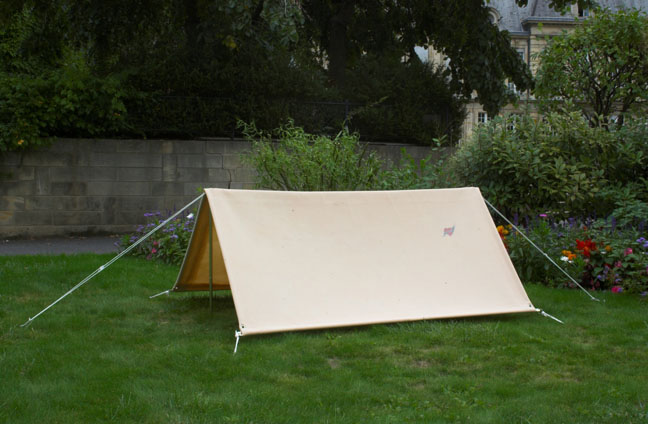
Edith Dakovic Home is Where the heart is 2007 silicone, human hair, pigment, tent hardware
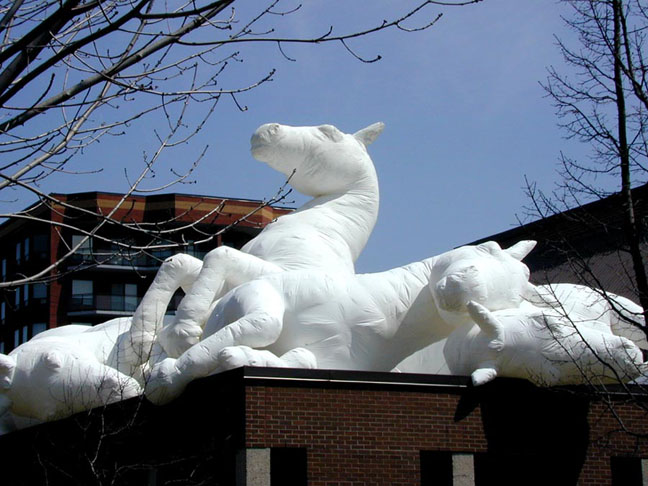
Max Streicher Horses 2003 vinyl and electric fans
The largest exhibition of contemporary Canadian art held in Denmark; featuring installation, video and mixed media works by:
Paul Butler, Edith Dakovic, Angela Grossmann , Diane Landry, Nicholas & Sheila Pye,
Jessica Thompson, Max Streicher, Robert Waters
The show will occupy three sites across the town of Viborg, the Kunsthallen Brænderigården at Riddergade 8, Senko at Sct. Mathiasgade 35 D and an outdoor installation at Viborg Svømmerhal at Banegårdspladsen 1, all within a 3km route.
FASTWÜRMS - DONKY @ NINJA @ WITCH opens at AGYU Wednesday, Sept. 26, 6 -9 pm.
Don't forget to bring your torches, pitchforks, ignorance and fear, townspeople!
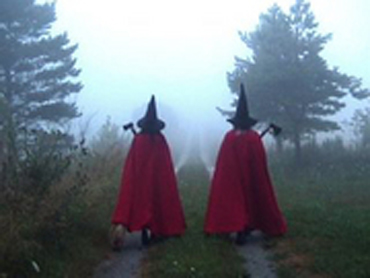
Red of Tooth and Kaw 2001 digital video still
And don't forget to loudly ask: "Haven't I seen some of this installation at Zsa Zsa? Why isn't that mentioned in the PR from York? Is that what they meant by Queen Street West Storefront Exhibitions? Isn't it easier and faster just to write Zsa Zsa? Now why would the AGYU not do that? Is everyone mad at each other now?"
[update: Info about Paul Petro and Zsa Zsa is on the pdf file, just not on the mailed print version]
[shit fuck damn, I wanted to see some sissy fights]
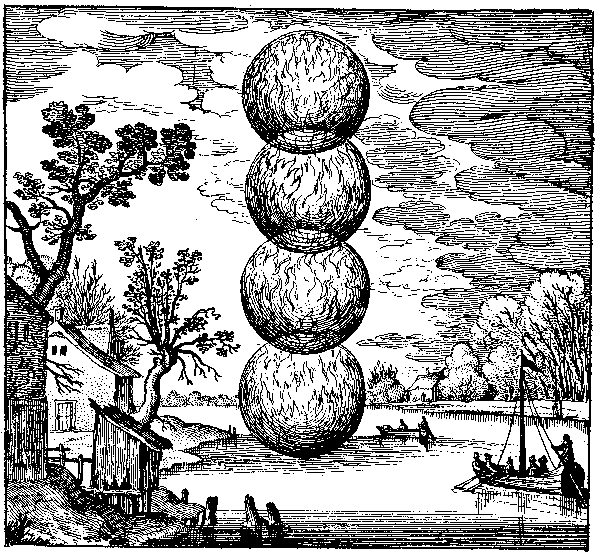 Emblem XVII from Michael Maier,Atalanta fugiens (Oppenheim: Hieronymus Gallerus, J. Theodorus de Bry, 1618). Borrowed from Hyle "The historians who make alchemy their particular interest are sometimes looked on as eccentrics: their methodology may be impeccable (I mean, good archival research, sound iconographic analyses), but their choice of subject matter makes them suspect. In that respect art historians who are interested in alchemy become one further example of the oil-and-water problem of mixing alchemy with any ‘legitimate’ discipline." - excerpt & illustration from James Elkins' Four Ways of Measuring the Distance Between Alchemy and Contemporary Art (2003) |
Sunday Devotionals
From Black Cat Bone - Burning The Flesh Off Modern Art
Hallelujah
an Evil Digital Film
produced by Force Majeure Film Studios
(a Holy owned subsidiary of Black Cat Bone Global Media Empire)
written, directed and edited by The Right Reverend James
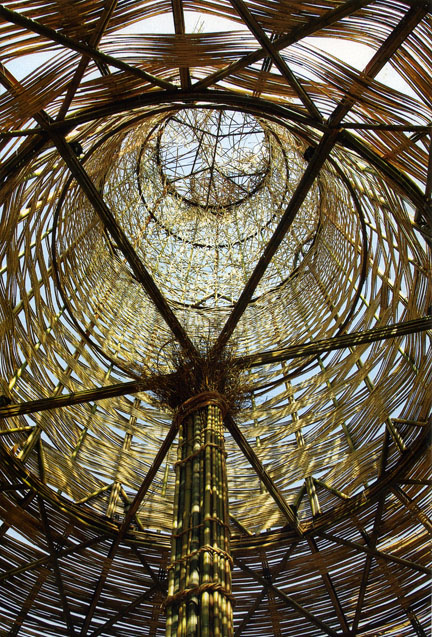

Tower In The Forest 2007 Bamboo, Rattan, Iron, 1500 x 1500 x 2700 cm
While installing at the tree museum we had the pleasure of making the aquaintance of Wang Wen-Chih, an artist from Taiwan, who constructed the wonderful Tree House (my images don't do it justice). These installation images are from an exhibition in Taiwan at the Plaza of Chiayi County Hall.
I've got one brain cell left, and you're getting on it. I'm struggling with my readings for school, trying to get a grip on the context. Since a lot of the writers we're looking at right now are studying ancient Greek and Roman art it's a bit of a stretch. But, in the midst of my misery, I have come across two very charming characters.
Johann Joachim Winckelmann was a gay aesthete living the Baroque era who hated all the art of the Baroque era. Instead, he just adored the Ancient Greeks - mmmmm....slave boy...mmmm. He had a lovely gentle approach to his studies, and reflected on the role of the historian as one who experiences (and mourns) the loss of the culture he studies. He was a Prussian who moved to Rome because there he could be a tour guide and meet boys. He had a sculpture of a faun in his apartment. I'm imagining a tragi-comedy about his life starring Philip Seymour Hoffman as Winckelmann and Brad Pitt as the noble naked Athenian who appears to him in his dreams. (update: the movie should be titled Death in Athens and it should be directed by Gus Van Sant)
The other guy I like is Aby Warburg, who died in 1929. He was really pissed off with the prevailing art history of the day that championed an autonomous formalist approach. For Warburg, everything interesting happened in the transitions between cultures, and he was just as interested in bad art as in good art. He suffered from mental illness and won his freedom from five years in a mental institution by delivering a great big lecture on the Pueblo Indians and the symbol of the serpent. He was worried about technology and the way that civilization's advancements were destroying cultures. Like Winckelmann, he also reflected a lot about the objective/subjective dichotomy in the role of one who studies history. Unlike his contemporaries, he was invested in content, myth and the dark murky side of meaning.
Warburg opened his own library that was an all-over-the-place collection of stuff designed to foster interdisciplinary scholarship. He also worked on a massive picture book, which he never finished. The book was to be a big collection of diverse images, arranged collage-style in a non-heirarchical fashion (and without captions or comments). The book had several working titles, the most official one being Mnemosyne (the goddess of memory) and the funner ones being Ghost Stories for Grown-ups and Picture Book for a Critique of Pure Unreason. Exhibitions of Warburg's images were mounted (I think by him) at his library. You can see documentation here. The first thing I think of is Luis Jacob's Album III at Documenta. I think the Warburg movie should be titled Ghost Stories for Grown-ups and Willem Defoe should have the starring role. (update: on second thought it should be an illustrated novel and Von Bark should write it and Scott Carruthers should do the drawings)
augh. sibling rivalry is always bad, but when one sibling gets a video made about their artwork with sexy German voice-over narration, it gets really really bad. Go here and click on "loss of signal."

I am going to have to pay more attention to detail if I am going to get through school. Of course, it is only the day before class that I realise one of the essays I've been reading is not required, and at the same time I have completly ignored an essay that is. D-oh! oh well, the one I wasn't supposed to read was pretty good. It's about explanation and description of artworks, and the various implications of different kinds of words and situations. Here's a bit that I thought I'd share, since it applies directly to L.M.'s dog, who is a force of nature, if not a work of art.
In everyday life if I offer a remark like "The dog is big", the intention and effect will depend a great deal on whether or not that dog is present or known to my hearers. If it is not, the 'big' — which, in the context of dogs, has a limited range of meaning — is likely to be primarily a matter of information about the dog; it is big, they learn, rather than small or middle-sized. But if it is present — if it is standing before us [perhahps rubbing it's gi-normous slobbery grinning head in your lap] as I talk—then 'big' is more a matter of my proposing a kind of interest to be found in the dog: it is interestingly big, I am suggesting. I have used 'dog' to point verbally to an object and 'big' to characterize the interest I find in it.
From Michael Baxandall's "Patterns of Intention" in The Art of Art History: A Critical Anthology, Donald Preziosi, ed. (Oxford, New York: Oxford University Press), 1998. pp. 59-60
I grew up hanging around the university where my dad taught, I've visited universities for work, and I have meaningful ongoing relationships with lots of people who have degrees from universities. So I guess I sort of thought I had and idea of what going to university might be like. As it turns out, it's an even more immersive world than I predicted, and I feel kind of like I'm travelling to another planet (shades of high school, where my main survival mechanism was to constantly mutter to myself "I'm an alien observer here" and watch The Man Who Fell to Earth repeatedly). But, as my dear friend and colleague Rev. Earl Chunx reminded me: "You can do it. It's a real thing in the world and it's good to know about it." And I do like the fact that educated adults have contracted to help me cram a bunch of potentially useful information into my (aging) noggin.
"Methodology" is the keyword for my first week. It's really important to have one. I am going to have to figure out how to get one without losing my bearings completely. Wikipedia says this:
Methodology refers to more than a simple set of methods; rather it refers to the rationale and the philosophical assumptions that underlie a particular study.So the beginning of the practice of studying art history seems to be mostly about studying the history of art history. I'm good with that! I like meta-levels. But, while dissecting the constructed narratives of western thought, it's a little tricky to figure out how I am going to participate in it.
The biggest change I can detect so far in my art-attitude is that, while I have always respected James Elkins with a certain interest and reserve, now he is my saviour and I am suddenly full of gratitude. His analyses of the history of art history are giving me a context for this whole school business that is helping me understand why I am so far feeling like an utter freak up there on the York U campus.
For instance, in this old Bad at Sports podcast, he talks about the fact that art critics are a separate breed from art historians, that criticism is not really part of academic methodology, and futhermore journalists who write about art for the popular press don't even register on the academic radar, despite the fact that in their worlds they feel very much like part of the bigger art picture. According to Elkins, most academics would never bother to cite a writer like Jerry Saltz. It's weird (is it true? I'll have to snoop around...). Elkins believes that ideas trickle down from academics to critics and curators, into the museums and popular press (really? I always thought it all got spread around sorta laterally and spiderwebby. If not - yike!). He also makes the strange suggestion that maybe journalists should do something that would make them impossible to ignore within academia (like...like what? Intriguing.)
There is an email going around, instigated by Richard Fung, that I want to re-post here (for the full version, with more info, see rabble.ca):
Dear friends and colleagues:4. DON'T FORGET your name, address, and postal code at bottom
You are being forwarded this email as a person who cares about Toronto.
Did you know the city's budget crisis could mean the end to theatres, galleries, festivals, concerts and all funding to writers, artists and musicians? It could also mean the end to libraries, community centres and health programs? Everything that makes Toronto one of the world's most livable cities.
Your action now can prevent this.
The city has never been closer to the brink. In just 30 seconds you can help avert cuts to the fabric of our city:
1. CREATE a new email, addressed to clerk@toronto.ca and cc'd to: dmcguinty.mpp.co@liberal.ola.org
hhampton-qp@ ndp.on.ca
john.tory@ pc.ola.org
2. TYPE the following subject line : "Yes to land transfer tax. Please copy to Mayor and City Councillors (arts)" (the clerk will forward it on to the Mayor and all the councillors: adding the arts in brackets means that arts friendly emails get tracked and tabulated)
3.PASTE this paragraph into the body of the email (or make up your own):Dear Mayor Miller and City Councillors:
My Toronto includes:the artsTo protect my city, I support the land transfer tax as an immediate solution to Toronto's financial crisis.
libraries
community centres
recreation programs
public health services
museums
and the TTC
Your name
Address
Postal code
5. SEND!
Please do this today. The city vote will likely be September 20!
10,000+ emails need to reach City Council this week. Each one will be read.
Please forward this call out widely.
The Road North/The Road South
Carlo Cesta, Michael Davey, John Dickson, Rebecca Diederichs, Brian Hobbs,
Lorna Mills, Lisa Neighbour, Chantal Rousseau, Lyla Rye, Kate Wilson and Johannes Zits.
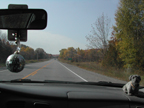
In celebration of the Tree Museum's 10th Anniversary, Persona Volare was invited to mount an exhibition at Harbourfront's York Quay Centre. Opening Friday, September 14, 6-9 pm running until Sunday, November 4, 2007.

left to right: Kate Wilson, Carlo Cesta, Rebecca Diederichs
...then into the forest with GRANITE CLUB at the Tree Museum near Gravenhurst (Map) opening on Sunday September 16, 2007 noon to 5pm.

left to right: Michael Davey, Chantal Rousseau, Lorna Mills
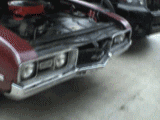

I have two shows opening on Thursday night this week. I will be at the show in Hamilton, but Rebecca Diederichs and Gordon Hicks will be at the show in Waterloo. I'm very happy about both of these touring shows and I hope everyone gets a chance to see them.
Quantal Strife

Scott Carruthers, Crystal Mowry, Marc Ngui
curated by Sally McKay
(organised by Ann MacDonald and Carol Podedworny)
Opens at McMaster Museum of Art in Hamilton on Thursday, September 13th, 6-8 pm
Details and directions: www.mcmaster.ca
Neutrinos They Are Very Small
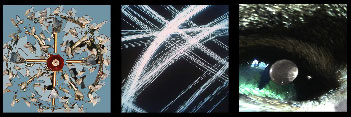
Rebecca Diederichs, Gordon Hicks, Sally McKay
curated by Corinna Ghaznavi
(organised by Celeste Scopelites, Jan Allen and Andrew Hunter)
Opens at Render Gallery (University of Waterloo) on Thursday September 13th, 5-8 pm
(We will also have a Saturday afternoon closing event later in October with performance lecture and an all ages Art and Science Lab) Details and directions: www.artgallery.uwaterloo.ca

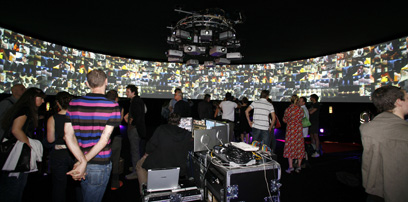
Here's an excerpt from Under the Bridge a recent piece by Oliver Laric, one of the masterminds behind VVORK, commissioned by the ICA and shown at Trafalgar Square, London on a 16 screen 360° panorama.

Curated by Ginny Kollak
David Diao, Dave Eppley, Lorna Mills, Tim Rollins and K.O.S., Rene Santos, Mika Tajima
At the Tang Museum, Saratoga Springs, New York.
(site of America's oldest racetrack, I'll have you know)
Bold yet shifty, stripes are a powerful pattern. Their marks are found everywhere— zipping through toothpaste and across running shoes, coating neckties, spinnakers, and zoot suits. Hovering somewhere between line and shape, stripes might signal a disturbance or coax order from disarray. They seem to move quickly but can command us to stop. They bring things into focus, making objects visible or prominent, but also camouflage what they cover, teasing the eye with their flickering forms.Official opening Sept. 8 and running to December 30, 2007
Stripes have long been a marker of transgression; people who operate outside the norms of society, like prisoners, clowns, or even artists, are often dressed in stripes. At the same time, stripes represent authority: generals mark their power in bars on a sleeve, while a thin striped beam at a railroad crossing stands for the impenetrability of a locked gate. Stripes of all sorts, from street barriers to beach umbrellas, are part of this potent iconographic legacy. As a visual language, they conjure a multitude of contradictory meanings and emotions.
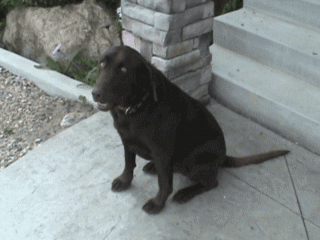



It's almost as if Sally wrote the first sentence of the copy for this Rhizome blurb about Joe McKay's show at Brooklyn’s VertexList.
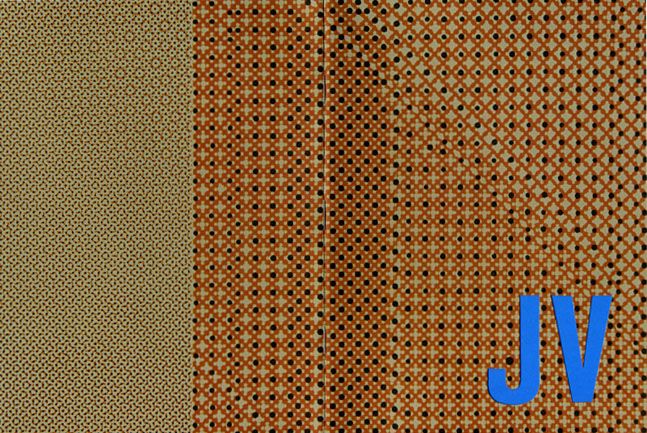
Excerpt from "Propane Flames & Brain Coral: The Chimerical World of Julie Voyce"
by R.M. Vaughan*
If I read a book and it makes my whole body so cold no fire can ever warm me, I know that is poetry. If I feel physically as if the top of my head were taken off, I know that is poetry. These are the only ways I know it. Is there any other way?
- Emily Dickinson
No Emily, there is no other way.
The same goes for art – it don’t mean a thing if it ain’t got that swing, as you were so vividly paraphrased a generation later.
Art without sensuality is merely dissertation. Art without a pulse, a presence, something you can feel moving around you and, if you’re lucky, inside you, is merely advertising, a clever billboard for a set of otherwise dry ideas. Art must sing, howl, or at least yodel a little to get my attention. A giggle is better than a sermon, a pinch more meaningful than a knowing glance (and far more tangible).
So, let us thank the blazing solar flairs, puffy clouds and double rainbows for Julie Voyce, an artist who knows a thing or five about showbiz, belly laughs, prestidigitation, burlesque teases, snappy dressing and the call of the wild. Julie Voyce is David Lynch in a world overrun with pinched documentarians, Elsa Schiaparelli surrounded by Gap outlets, Divine at a Conservative policy convention, Frida Kahlo holding her eyes open with toothpicks (and the odd monkey’s paw) at Documenta.
Julie Voyce is a starred artist (as in pixelated, sparkling, diamond shiny), not an art star. Art stars come and go, like academic fads and couture theorists, but starry artists are born eternal.
Voyce's catalogue JULIE VOYCE: PASTE-UP is available at Art Metropole,
788 King Street West, Toronto, ON
Lee Goreas: Par For The Course until September 8th
at Birch Libralato, 129 Tecumseth St. Toronto



The Pinnacle 2007 C prints 20 x24 in.
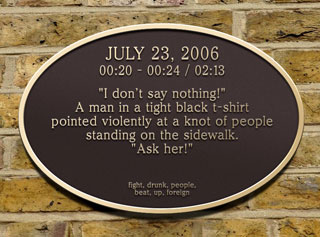
I recently had the pleasure of writing an exhibition essay for Grand Gestures, a new project by the video collective 640 480. The show opens this Thursday at two locations in Toronto:
5:00 to 7:00 at Trinity Square Video
7:00 to 9:00 at Gallery TPW
I just came across the archives of a 2002 online conference on Art and Cognition. Nerdfest!!
"In our call for papers, we merely asked authors to reflect on whether the cognitive sciences could tell us anything of relevance about art; and vice versa, whether an analysis of artistic experience could tell us anything of particular interest about the brain."I think this paper, Art as enaction, by Alva Noë is particularly good, along with the sidebar comment thread.
BGL (Jasmin Bilodeau, Sébastien Giguère and Nicolas Laverdière)
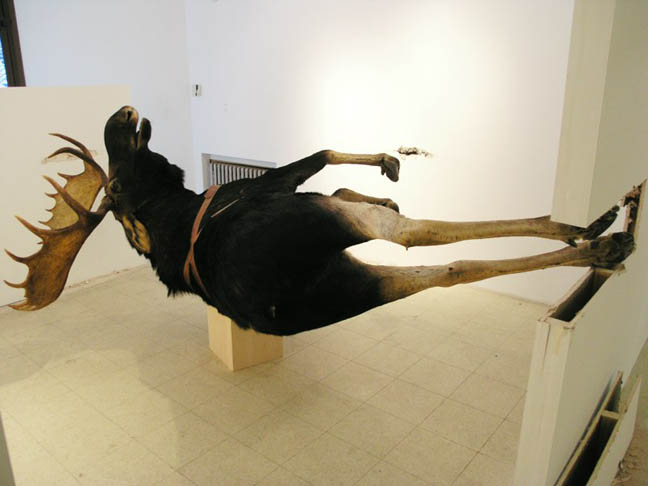
Venise A.K.A. the pivoting moose 2006 moose, drywall, installation at Art Mur
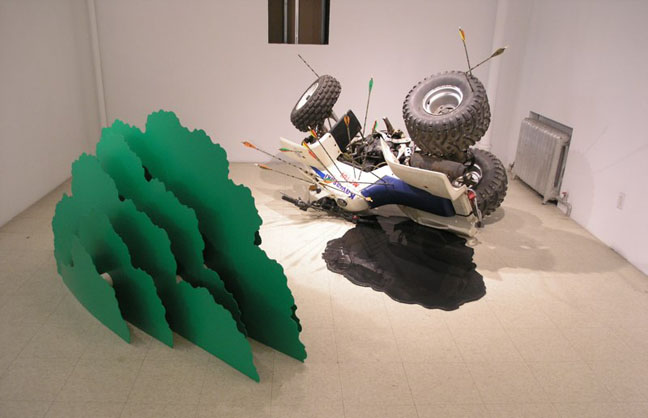
Bosquet d'espionnage 2004 and Jouet d'adulte 2003 mixed media
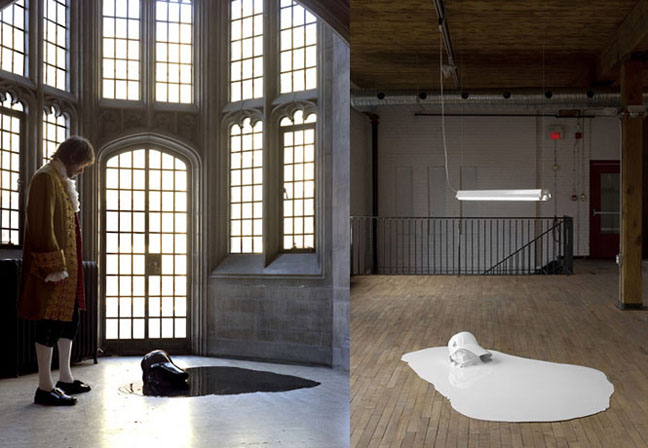
Good Night Darthy 2006 and Born Again 2007 mixed media

Promener son chien (To Walk the Dog) 2005 mixed media
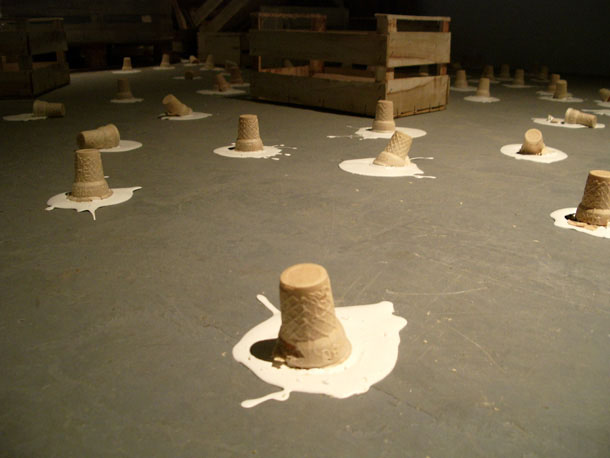
Escultura con leche (Sculpture with Milk) 2007 mixed media
BGL will be exhibiting La senteur de mes mains/The Marks of my Hands, curated by Mona Filip, at the Koffler Gallery, 4588 Bathurst st. Toronto. Opening Thursday, September 6, 6 to 9 pm. running until November 25th, 2007.
Sunday Devotionals
Get thyself over to the Republic of Sestakastan and read the latest film strip from my friend Morse (formerly of Media Needle).
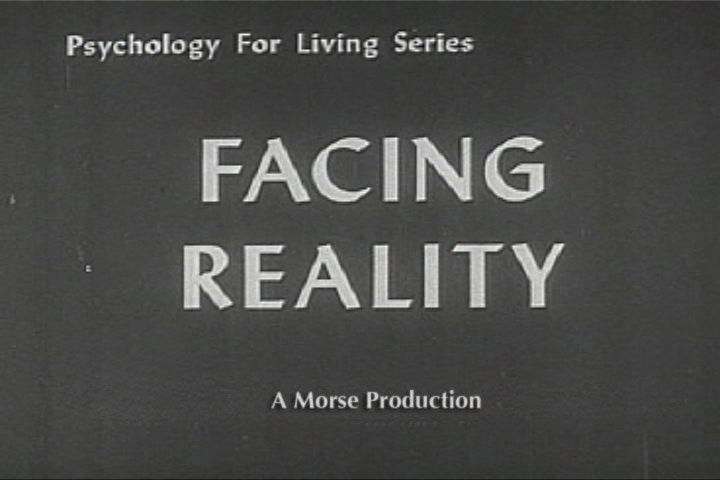
While counselling me not to load up on too many courses in my first term, an adviser posed the ominous question "How long has it been since you've read Hegel?" I blinked at her like a deer in the headlights. "Uh, eternity?" (No kidding. I've barely read any Kant! And to answer the spirit of the question, my BFA with Art History minor was 17 years ago.)
In a state of not quite panic but something close I spent yesterday afternoon reading James Elkins' Stories of Art. It's a short book that summarizes various art history survey texts throughout the ages, (and around the world), and ultimately paints a picture of the study of art history as an inescapably western phenomemon. It's easy reading, and...Hegel shows up! yay. According to Elkins, Hegel is a bit of a thorn in the side of art history, a guy with a pernicious point of view that we'd love to purge, if only we could.
Among Hegel's many ideas about art, two have been particularly important for subsequent art history: the claim that art moves forward through time in accord with certain specifiable laws; and the claim that at any given time, all the arts of a culture are in harmony."At least these themes sound familiar. I did learn the term "teleology" back in school and it's stuck with me. I remember reading Stephen Jay Gould, not quite so long ago, as he argued against the sticky notion that evolution has a goal in mind (...and that human civilzation is its crowning glory). This is an easy idea to dismiss rationally, but it is much harder to divest our everyday thinking of such narrative trajectories. Progress is a pretty deeply embedded concept.
[...]
"In Hegel's view, art progresses: it actually moves forward rather than simply changing or wandering. His sequences are meliorist, that is, the art actually improves, because better expressions of the Idea or Spirit are to be desired over less accurate ones.
What is now often called the diachronic march of art through history is one of Hegel's two influential theories. The synchronic theory, which explains how art at any given time all hangs together, is just as important."
[...]
"Hegel is one of those insidious problems that seems easy to solve: afer all, can't I just say that I will stop assuming art progresses or that all arts are tied to a central spirit? It turns out that I can say it but I cannot write that way, because the resulting lecture or book will sound incoherent. Listeners, viewers, and readers expect sense and structure in their art history, and so far at least the overwhelming majority of attempts to write different kinds of art history have failed."
From James Elkins, Stories of Art, (New York: Routledge*) 2002, pgs. 52-55
Another thing this makes me think of if the physics problem of time — why does it only go one way? And philosophic problems of point of view and memory and consciousness. And other things I've thought about before sometimes like maybe even this old post on narratology and ludology.
So the upshot for me is that while Elkins' book makes the whole art history project seem mildly claustrophobic, I am starting to feel somewhat enthusiastic at the prospect of "reading Hegel" (ulp).
*I'm not normally too picky as a reader, but as a sometimes-editor I have to say: man this book is full of typos and clumsy hyphenation! What gives? I thought Routledge was the kind of press that wouldn't scrimp on editors and proof readers.